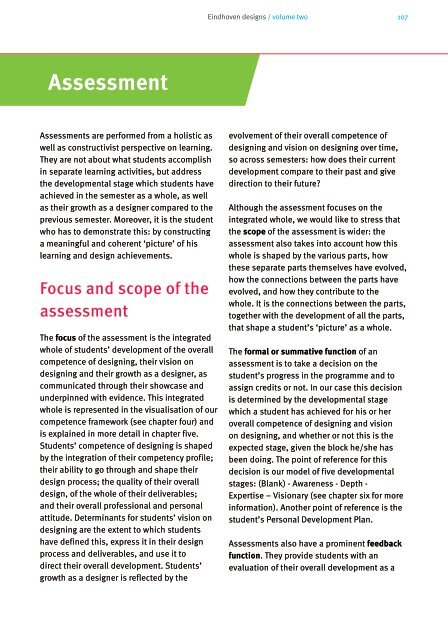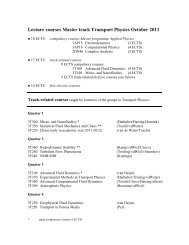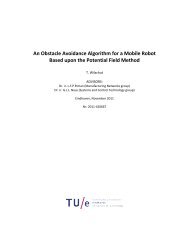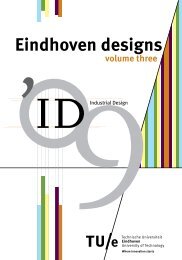Education guide 'Eindhoven designs' - Technische Universiteit ...
Education guide 'Eindhoven designs' - Technische Universiteit ...
Education guide 'Eindhoven designs' - Technische Universiteit ...
Create successful ePaper yourself
Turn your PDF publications into a flip-book with our unique Google optimized e-Paper software.
Eindhoven designs / volume two 107<br />
Assessment<br />
Assessments are performed from a holistic as<br />
well as constructivist perspective on learning.<br />
They are not about what students accomplish<br />
in separate learning activities, but address<br />
the developmental stage which students have<br />
achieved in the semester as a whole, as well<br />
as their growth as a designer compared to the<br />
previous semester. Moreover, it is the student<br />
who has to demonstrate this: by constructing<br />
a meaningful and coherent ‘picture’ of his<br />
learning and design achievements.<br />
Focus and scope of the<br />
assessment<br />
The focus of the assessment is the integrated<br />
whole of students’ development of the overall<br />
competence of designing, their vision on<br />
designing and their growth as a designer, as<br />
communicated through their showcase and<br />
underpinned with evidence. This integrated<br />
whole is represented in the visualisation of our<br />
competence framework (see chapter four) and<br />
is explained in more detail in chapter five.<br />
Students’ competence of designing is shaped<br />
by the integration of their competency profile;<br />
their ability to go through and shape their<br />
design process; the quality of their overall<br />
design, of the whole of their deliverables;<br />
and their overall professional and personal<br />
attitude. Determinants for students’ vision on<br />
designing are the extent to which students<br />
have defined this, express it in their design<br />
process and deliverables, and use it to<br />
direct their overall development. Students’<br />
growth as a designer is reflected by the<br />
evolvement of their overall competence of<br />
designing and vision on designing over time,<br />
so across semesters: how does their current<br />
development compare to their past and give<br />
direction to their future?<br />
Although the assessment focuses on the<br />
integrated whole, we would like to stress that<br />
the scope of the assessment is wider: the<br />
assessment also takes into account how this<br />
whole is shaped by the various parts, how<br />
these separate parts themselves have evolved,<br />
how the connections between the parts have<br />
evolved, and how they contribute to the<br />
whole. It is the connections between the parts,<br />
together with the development of all the parts,<br />
that shape a student’s ‘picture’ as a whole.<br />
The formal or summative function of an<br />
assessment is to take a decision on the<br />
student’s progress in the programme and to<br />
assign credits or not. In our case this decision<br />
is determined by the developmental stage<br />
which a student has achieved for his or her<br />
overall competence of designing and vision<br />
on designing, and whether or not this is the<br />
expected stage, given the block he/she has<br />
been doing. The point of reference for this<br />
decision is our model of five developmental<br />
stages: (Blank) - Awareness - Depth -<br />
Expertise – Visionary (see chapter six for more<br />
information). Another point of reference is the<br />
student’s Personal Development Plan.<br />
Assessments also have a prominent feedback<br />
function. They provide students with an<br />
evaluation of their overall development as a

















